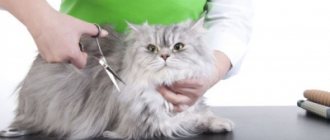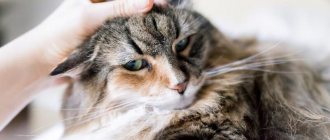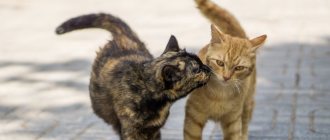If the cat's behavior after mating causes concern in the owner, it is better to show the animal to a veterinarian rather than let the situation take its course. A female cat that has no health problems should become pregnant after mating. Usually the pet calms down and prepares for a new role. But if pregnancy does not occur, and a new estrus begins untimely, the owner should find out the reasons for this disorder and, under the supervision of a veterinarian, try to eliminate them.
False pregnancy: symptoms and consequences
Even with an imaginary pregnancy, the female has all its external symptoms. This is a condition in which the cat is not truly pregnant, but she is showing all the signs of pregnancy. The main causes of the pathology:
- pathological changes in sperm cells;
- progressive inflammatory processes affecting the male reproductive organs and negatively affecting the quality of sperm;
- frequent exploitation of the male, due to which the concentration of biological fluid decreases;
- low sperm activity.
To avoid such complications, before mating, the cat owner is advised to inquire about the health of the gentleman and ask his owner to provide all supporting certificates and medical documents. Like a normal pregnancy, a false pregnancy is accompanied by similar symptoms:
redness and enlargement of the nipples; swelling of the mammary glands; abdominal enlargement; careful behavior.
This condition can become a trigger for cancer. Before the onset of an imaginary birth, the animal meows, worries, and looks for a place for a nest. After “birth”, milk production is observed. False pregnancy is dangerous not only for the mental, but also for the physical health of the cat. Hormonal levels are disrupted, and the risk of developing dangerous diseases of the reproductive system, including cancer, increases.
Should there be discharge after mating?
Within 2-4 days after mating, clear, watery discharge from a cat is considered normal. If there are no pathological inclusions or unpleasant odor, there should be no cause for concern. But discharge of brown, bright red or brown color with an unpleasant aroma is considered a sign of pathology. Typically, such symptoms indicate a sexually transmitted infection, inflammation of the uterus and ovaries, as well as a miscarriage. With such symptoms, it is necessary to call a veterinarian at home. It is unlikely that you will be able to save the pregnancy, but it is possible to prevent complications.
What other cases are there?
The signal that the female is ready for mating is estrus. How do you know if your pussy has started sexual intercourse? She experiences obvious “languor”:
- purrs often and loudly;
- fawns or turns into an aggressive touch-me-not;
- rubs vigorously against all sorts of objects;
- takes a characteristic pose when stroking the back: the trembling tail is pulled to the side, the rear is raised, the chest falls to the floor.
The “lady” is sent to the “gentleman” on the third day after such signs appear. The guest comes with her things: food, bowls, litter tray. No one knows how long it will take to breed a cat and a cat. You need to plan for 1-3 days. The first time it may take a week.
When the “lady” gets used to it, she herself begins to flirt with the male. After waiting for the aggression to die down, you need to leave the “newlyweds” face-to-face. How long does a coitus session last? Usually “this” occurs in cats for up to 20 seconds, accompanied by heartbreaking screams. How long after can I visit my clients? It’s worth delicately waiting a couple of minutes for the disturbed duo to calm down.
We suggest you read: Disease ichthyophthyriosis or semolina in aquarium fish - treatment
How to understand that genital contact has occurred? Silence reigns in the room where the “young” remain. After being untied, Murka's behavior changes dramatically: she becomes tolerant of her partner, lies down next to him, rolls around on the floor, her genitals enlarge and turn red.
How many days does mating last for cats? It all depends on the character and experience of the “newlyweds”. Ambitious murki behave aggressively, shy ones huddle in a corner. The boyfriend must be given time to seduce the “lady”.
In veterinary practice, there are a number of specific cases when the sex hormonal background of a sterilized individual was determined by diseases occurring in the thyroid gland. Aligning and adjusting the balance of hormones in this situation is not an easy task, which may include a number of stages:
- Exclusion of hormone-producing tumors;
- Chemical suppression of sex hormones.
Pairing
During estrus, the female makes special sounds, purrs and crouches to the floor.
When she is located towards her partner, she takes a special pose, arches her back and moves her tail. The male holds her by the withers with his teeth and covers her. Sexual intercourse lasts several seconds. If this is your first mating, then it will be important to find out in advance how the cat behaves after mating. She pushes the cat away, makes characteristic high-pitched screams, begins to lick herself furiously and demonstrates her reluctance to continue communication. In some cases, she may show aggression and attack. In others it is simply secluded. Sometimes owners wonder why the cat tumbles after mating.
There is no need to be afraid of such behavior. The cat behaves this way after mating not because she is in pain. It’s just that nature very wisely doses the sexual desire of females. In this case, it has fulfilled its function, and repeated sexual intercourse will become possible only after some time. Usually, in order for pregnancy to occur with a 99% probability, cats are bred three times, on the second or third day of ovulation. Another option is to allow animals to mate during the three most favorable days of estrus.
Timing of puberty
Before allowing an animal to mate, its owner must ask the important question of whether his pet is mature enough to participate in sexual intercourse. The onset of puberty in most cats occurs in the eighth month of life (however, this figure may vary depending on the breed)
However, it is important to remember that puberty precedes physiological maturity. Therefore, not all young cats that have just begun to come into heat can benefit from mating
Puberty in cats often goes unnoticed by their owners.
Physiological maturity implies the final completion of all maturation processes and occurs in different breeds between one and two years (most often within a year and a half). And if this criterion is not so important in relation to males, then mistakes cannot be made with females. The fact is that a physiologically immature body is not ready for pregnancy, so mating can lead to various complications and the birth of weakened kittens.
Signs of puberty
Puberty is not always noticeable - some owners do not even notice when their pet crosses the line between a kitten and a mature cat. Much depends on the cat itself, its temperament and habits. In addition, the level of hormones in different animals can be different, which also affects the behavior of our pets.
Cats continue to search for a partner even if this desire is impossible to fulfill.
In males
The most striking manifestations of maturation in males include the following behavioral features:
- marking the territory;
- increased level of aggressiveness towards other animals in the apartment and even towards the owner himself;
- loud meowing and other screams that are unusual for a cat in its normal state. Often such “chants” occur at night;
- refusal to eat or severe loss of appetite;
- attempts to escape outside. In its desire to fulfill its sexual needs, the cat strives to go free and find the cat. Many owners take such a gesture as ingratitude, but this is absolutely not the case.
Cats mark their territory to attract females with a strong scent.
In females
Sexual arousal in females is rarely accompanied by aggression, unlike males. Cats tend to show their willingness to mate in a softer and more subtle manner. Signs indicating puberty in females include the following:
- expressed affection. During the period of estrus, cats can actively caress not only males, but also the owner himself, sometimes causing him tenderness due to ignorance of the reasons for such behavior. The pet can also rub against inanimate objects - table legs, door frames, etc.;
- mucus discharge from the reproductive organs. In most cases, these allocations are so small that they are not any useful criterion;
- meowing, purring and other signals given to males;
- vaginal swelling;
- lack of interest in food.
Arching of a cat indicates readiness and need for mating
Gulena cat: all the subtleties of the process
There is an opinion that a cat wants a cat in the spring, or more precisely, in March. And it is true... in relation to the “correct” cats living “in nature”. Natural laws tell them to walk in the spring, feed their offspring in the warm season, and in the cold, think only about survival. Unfortunately or fortunately, the sleek, mustachioed pets who live in our homes look down on this opinion. A sweet life and a good diet lead to the fact that they are ready to reproduce throughout the summer and autumn months, and even winter.
At what age does a cat start asking for a cat?
What time do cats start walking? It depends on its breed: usually a cat begins to ask for a cat for the first time in the sixth to tenth month of life. However, despite the onset of puberty before the age of one year, she is not always able to give birth to healthy babies at this time. If a cat wants a cat for the first time, it is advisable not to let them meet at least until the age of one and a half years.
Signs of estrus in a tailed “bride”
What signs in an animal's behavior indicate that a cat wants a cat? There are a lot of them, and it’s difficult not to notice the signs that a cat has gone on a spree:
- the cat screams both day and night, trying to run away from the house;
- cannot stay in one place;
- cuddles up to people and rubs against objects;
- calm cats become aggressive, and vice versa;
- rolls on the floor, lifts its tail up or to the side, tramples with its hind legs, as if squatting on them;
- loses appetite or almost refuses to eat;
- noticeable discharge from the genitals;
- urination becomes more frequent.
How often does a cat ask for a cat?
How many days does a cat walk? The duration of her estrus varies from person to person. But the end of this period, when the cat has gone on a spree, does not mean at all that the owners can relax for a long time: if the “bride” did not manage to meet the “groom”, screaming and rolling on the floor can resume after a week or two. And to the question “how many days does the cat ask for the cat?” the exhausted owners answer: “all 365 in a year!” How this looks in practice, look at the video (Alexey Karasev).
How long does a cat walk?
How long does the cat ask for the cat? The duration of estrus is usually from 7 to 20 days. If the “bride” does not become pregnant, then the “wedding requirements” will be repeated every 14-21 days until she is expecting children or the resting season begins. Occasionally, a third option is also possible, the so-called false pregnancy, which postpones the appearance of a new period when the cat wants a cat.
Stages of heat
The estrus process can be roughly divided into four stages.
- The first is called proestrus. It lasts from 1 to 4 days and is characterized by the relative calm of the animal. The beginning of the period when the cat went on a spree is indicated only by quiet throaty meows and obsessive caressing of the owners. The tailed cat is not yet ready to meet a roaming cat.
- The second period, estrus, can last 7–10 days. The female begins not just to scream, but to scream at the top of her lungs. When you stroke her back, she crouches, moving her tail to the side. This means they are ready to mate. If you want to let her have a kitten or several, it is better to bring a male on the 3rd-5th day of estrus.
- In the third period, metestrus, which lasts from 3 to 12 days, the pet that has walked with the “groom” will drive away all applicants. When fertilization does not occur, a false pregnancy may begin, very similar to the real one, but not ending in childbirth. True pregnancy in your pet lasts 60–70 days.
- In the last, fourth period, called anestrus, she calms down.
Popular questions
- How long does heat last? The duration of estrus (heat) is different for each cat. On average, estrus lasts seven days, but can sometimes reach 21 days. If the cat does not mate and does not become pregnant, the estrus may begin again, with two days between estruses.
- At what age can a cat become pregnant? A cat can become pregnant as soon as it reaches sexual maturity (about four months).
- At what times of the year can a cat become pregnant? Cats can become pregnant at any time of the year, especially in average climates, but mating and pregnancy occur most often in the spring.
- How long does pregnancy last in cats? 56 – 71 days. The average duration of pregnancy is 67 days.
- How many times a year can a cat kitten? Up to five times a year!
- On average, how many kittens can a cat give birth to at one time? On average, a stray cat gives birth to three kittens, but sometimes six kittens or more.
- Can a cat get pregnant while nursing kittens? Certainly! Typically, cats go into heat 1-2 months after giving birth, at which time they can become pregnant again. Some cats may go into heat a week after giving birth, which can lead to pregnancy.
- Is it possible to sterilize cats while they are nursing kittens? Yes. A cat that is spayed while nursing kittens will continue to produce enough milk for her kittens. Some veterinarians prefer to wait until the cat has stopped nursing her kittens before operating, because mammary gland development during nursing can make surgery difficult. If the cat can be kept indoors away from male cats, you can wait to have her spayed until she is no longer nursing kittens (then the entire family can be spayed or neutered). If the cat cannot stay away from cats while feeding, then she needs to be sterilized as soon as possible. Return your cat to kittens as soon as possible after surgery. If the lactating cat is feral and must be captured, it is advisable to capture the kittens as well (if possible), or wait until the kittens are at least six weeks old, so as not to leave the kittens without their mother for a long time.
- At what age do non-sterilized cats stop producing kittens? Unlike humans, cats do not go through menopause. Although fertility gradually declines over time, there is no specific age after which a cat can stop becoming pregnant.
- Can cats from the same litter mate and create kittens? Yes. It is for this reason that cats and female cats from the same litter living together must be spayed and sterilized before four months.
- Is it okay to let your cat give birth once before getting spayed? No! This will not bring any benefit to the animal. It is easier and safer to spay a cat before her first litter, or better yet, before her first heat. Recent experimental results have shown that spaying a cat before six months of age significantly reduces the risk of mammary cancer.
The nuances of the first mating
Significant difficulties may arise when a pet mates for the first time. There are certain features in how to match a cat with a cat for the first time. First of all, it is necessary that at the time of mating the pet is one year old; if the animal is purebred, then at least 1.5 years old. The event should be carried out only in the territory of the male. The pet should be brought to the first mating already on the first day of estrus, since an inexperienced animal needs more time to adapt to a new place and get used to the male.
In this case, the choice of cat is important. The animal must be experienced
Under no circumstances should a cat's first mating be with a male who has never mated before. In this case, both inexperienced (not untied) animals can not only disrupt the “date” and mating will not take place, but also receive mental and even physical trauma.
End of estrus
If professionals plan mating, they usually choose the middle or end of the cycle. In the last 3-4 days, there is a gradual stabilization of hormonal levels. The only risk is that if you calculate incorrectly, then there may be no additional time for re-matings. The heat will end, and you will have to wait for the next opportunity.
How should a cat behave after mating during this period? She usually calms down almost immediately. But you need to make allowances for the individual characteristics of the animal.
How and what to feed a pregnant cat?
First of all, the body of a pregnant cat needs good nutrition. From the first weeks, the amount of food can be increased by 10 percent. From the third week, the cat should be given one and a half to two times more food than usual. And starting from the 7th week and until the kittens appear, on the contrary, you need to reduce your pet’s diet.
In addition to enhanced nutrition, the expectant mother should receive everything she needs for the normal development of her offspring: proteins, micro- and macroelements, vitamins. Food for pregnant cats must be balanced. But the owner needs to be careful not to overfeed the animal. Food should be given in 3-5 doses.
When feeding ready-made food, you need to purchase special food intended for pregnant cats. It is advisable to use only high-quality premium food.
If the cat is accustomed to natural nutrition, then during pregnancy meat should make up approximately half of the daily diet. A cat can be given beef or veal, less preferably pork, and only in boiled form, since raw meat can cause worms in a pregnant cat.
While pregnant, your cat may experience constipation from time to time. In this case, add vegetable oils (canned fish oil) or vegetable puree (preferably beetroot) to her food.
Sometimes the opposite situation occurs - a pregnant cat begins to have diarrhea. Most often this happens due to the transition to unusual food during “dry” feeding, so experiments with food should be stopped during pregnancy. In case of diarrhea, the cat should be given smecta and enterosgel alternately (the difference between doses should be 2–3 hours).
Keep in mind that if your cat eats natural food rather than dry food, it is necessary to additionally give her vitamin and mineral supplements intended for pregnant women.
First contact requirements
A partner for a meowing ward is found in advance. They look through advertisements, go to exhibitions, prepare their pet for the decisive meeting.
Rules for mating cats:
- To avoid dangerous pathologies, estrus cannot be stopped with hormonal or other drugs.
- The first mating of cats requires a fully completed vaccination plan (4 weeks must pass after the last immunization).
- Half a month before intercourse, deworming is carried out.
- On the day of the meeting, the “bride” (as well as the “groom”) have their claws trimmed to avoid injury.
- It is wrong to bathe cats before mating: soap and shampoos muffle the smell of pheromones.
- At the crucial hour, they make sure that the female is moderately well-fed, well-groomed, with clean ears, clear eyes, and a shiny nose.
Mating a cat and its conditions:
- The breeder is supposed to be healthy, vaccinated, treated for worms, and externally well-groomed.
- To stimulate sexual activity, it is recommended to enrich the menu with B vitamins a couple of days before intimacy.
- The cat owner, as the owner of the “mating station”, is obliged to ensure that the meeting is successful: organize an acquaintance, competently stimulate the development of sexual relations, and be responsible for the comfort and safety of the furry guest.
The meeting of a pair of virgins is undesirable. It is fraught with psychological or physical damage.
HOW MANY KITTENS CAN A CAT GIVE BIRTH AT THE FIRST TIME?
On average, a cat will give birth to 1-6 kittens per litter, and this can depend on various factors. This is often influenced by the characteristics of the body, and even more often by the state of health of the animal. Cats have a bicornuate uterus, the horns of which contain fertilized eggs at the beginning of pregnancy. They attach to the walls of the uterus.
Since “space” is limited, more than 6 kittens are very rarely born in one litter.
The first birth is different in that during it cats give birth to no more than 3 kittens.
We will learn about the character of a British cat, discuss its features. We will tell you how long pregnancy lasts in cats: and find out the details.
By the way, the same feature is found in old cats. In general, in old age, these animals rarely give birth, but they can love other people’s kittens like mothers and even “adopt” them.
Choosing the time period of estrus
Estrus can occur in a hidden form, and the cat will begin to furiously ask for a male cat already on the 4th day. It is important not to make a mistake with the time interval of estrus
The next step is timing during estrus . The cat cannot become pregnant for the first 2 days. It is better to send her to the cat on the 3rd day and leave her for 3 days. The process of ovulation in cats begins after reaching a certain concentration of hormones in the body. One or 2 days of mating is not enough to pump up a certain level of hormones.
Knitting at home
A nulliparous female may behave too aggressively during her first mating and cause serious injury to her partner. Therefore, his owner must initially take this fact into account and think carefully about whether it is worth exposing his pet to such a risk. For successful mating, it is necessary to provide suitable conditions:
- A separate room is needed in which the female must spend several hours alone; this is done to develop a new territory.
- There should be a portable cage in the house to house an aggressive animal in an emergency.
- If this is the cat’s first mating, then a mating partner must be selected with experience in breeding.
- The estrus period should not come to an end, otherwise copulation may not occur.
The ideal time for mating is the first three days of estrus. At such a moment, the mating process will not take long to happen. Some cats experience stress when they leave their home. Because of this, estrus may stop for a short time. In this case, the cat needs to be petted more often to return it to its previous state. It is best to pet the animal in the tail area
The most important thing is to arouse the cat's interest with the help of smell.
If the cat resists and does not allow the partner to approach, then the animals should be left alone for a certain period of time so that they get used to each other. To quickly get acquainted, they need to be fed together, this way they get used to it much faster. You should not delay the days of dating; a maximum of one day is given for this, so that the cat has time to impregnate the partner before the end of the heat.
When mating cats of different breeds, it is important to note that incorrect crossing can lead to mutation of the fetus. The fold-eared breed can only be mated with a cat that has straight ears.
Otherwise, genetic deformities are possible.
How long does mating last?
An experienced partner is able to fertilize a female from the very first time. But this may not be enough for the cat, because after copulation, estrus will not be stopped, and completed sexual intercourse will cause even more excitement. An animal can demand a cat even when pregnant.
Therefore, you should leave the cats together for a few more days. In this case, the cat will be satisfied when returning home and will calmly bear offspring. The time the animals spend together should not exceed five days. Otherwise, there is a risk of giving birth to premature, dead kittens. In general, mating should last no more than three days.
Estrus is a physiological process caused by nature that is not influenced by either humans or cats. An animal can become pregnant only during estrus, and then only after a few days.
In the first days, the cat usually does not allow the cat to approach her.
The cat asks for the cat
Only after mating does ovulation occur and the egg begins to mature. The level of hormones responsible for the formation of the egg must reach a certain concentration. It takes two and a half days for the egg to mature.
The emergence of aggressive behavior and its conditions of occurrence
The cat may begin to behave threateningly, hiss, and constantly make strange, unfounded sounds that sound like a scream. For a female, changing the room in which she is located is stressful and, in this case, the cat may not allow the cat to be mated to her. Therefore, when a cat is moved to another house with a cat, the female demonstrates aggressive behavior. Here you can only use special drops or spray to make the cat calm.
When mating, it is important to leave the cat and the cat in the same room for several days, where there are no people. This is due to the short time for animals to get used to each other, and even an inexperienced cat, the cat can be intimidated and nothing will work out for them.
Reasons why mating may not work
- A young and insecure cat. If the cat is not in its territory or is too young (1 year), then its behavior will be cautious and unsure. This can scare away the cat and nothing will come of it.
- The cat did not find anything attractive in the “gentleman” and does not allow him to approach her. In this case, she takes a sideways position and begins to hiss; moreover, the process of hostility may be accompanied by attacking the partner.
- Disease. Before mating, you need to take your cat to the veterinarian, since various diseases usually affect this process. Even a slight malaise can have a negative impact, and then the cat won’t let the cat in anywhere. Possible pain during the mating process in a cat can be caused by inflammation of the glands, which is why the cat will not let the cat near and may rush at him. In addition, there may be pain during the normal process of estrus.
- The cat is not in heat or has already ended, which means the cat has not reached sexual maturity.
- The cat must be well-fed, so leave food for both animals and trays (each with his own) in the room. And also don't forget about water. Hunger, like illness, has a negative effect on cat instincts. If your furry pet has experienced a lack of appetite or apathy for several days before making the decision to mate, then you need to cancel all plans to merge a cat and a male cat.
- Another very important factor. It is necessary to take into account the age of the animals and their breed. Mating often does not work out if they differ at the genetic level, and then the cat may simply not allow the newly arrived cat to approach her.
© shutterstock
Psychology of cats. People who love cats
Everyone has their own hobbies: some people like to spend time watching TV series, others prefer active recreation or knitting, and some people love to caress cats, play with them, and talk as if they were talking to a person. Therefore, all cat lovers have common character traits, and psychological science provides an explanation for this. The cat symbolizes both independence and devotion, character and strength and affection, grace and fragility. People love cats because they either have certain cat-like traits or want to have those traits.
Surely, in recent years, you have noticed that the number of cat lovers’ communities on the Internet has increased. There are a lot of funny pictures and videos dedicated to your favorite pets. This is explained by the fact that the cat symbolizes home comfort, happiness and tranquility. Recently, people have been focused on living comfortably and happily, and a lot of effort and resources are spent on this. And if there is also a cat in the house, happy, well-fed, affectionate, then life is good.
Cats are loved because these animals love tactile contacts: you can stroke them, scratch them behind the ears, caress them, and fall asleep with them. In this way, modern people relieve stress and make up for the lack of love and tenderness.
The cat symbolizes home comfort, happiness and tranquility
Interesting fact! Very often you can notice that young couples in love who begin to live together, first of all, have a cat in the house, and only years later children. This is explained by the fact that a cat does not require much attention and young people subconsciously perceive a cat as a child. After a while, people become convinced of the strength of their union and decide to have a baby.
Demonstration of trust
A satisfied and calm cat in its territory playfully rolls from side to side, gracefully stretches out and squints its eyes. At the same time, her muzzle radiates bliss and serenity - this is how an animal invites a familiar person to careful caresses and gentle stroking.
A sign of friendship and goodwill towards a person or fellow tribesman for a cat lying on its back is the stretching of its front paws with soft pads.
The cat is limping, crying in pain, won’t sit on its butt – what is this?
First of all, it is necessary to examine the female for bites and deep scratches. Cats, in the heat of passion, grab the bride by the back of her head, neck, and scruff with their teeth, scratching her in order to hold her in place during coitus. This is why all breeders recommend trimming their pets’ nails before breeding in order to somehow minimize injuries.
In the article about mating it was already written that you should not organize a meeting between two virgins, otherwise injuries cannot be avoided. Inexperienced animals can adapt to each other for a long time, the cat does not succeed, but at the same time he is not able to lose his long-awaited sexual partner and holds her by all possible means (teeth and claws).
It is quite possible that the couple was disturbed during boarding, they jerked in surprise, fell off somewhere and the cat could have damaged something.
Solving problem situations
In the affairs of amorous animals, not everything goes smoothly. In some cases, a couple needs help from:
- The cat hisses at the cat when mating. There is no need to rush animals, especially inexperienced ones. They need more time for foreplay.
- The cat is smaller in size than its partner, as a result of which the cat rests on its back. In this case, it is necessary to send the male.
- The bride falls on her side during sexual intercourse. In such a situation, they support the female.
We suggest you read: What to feed a castrated cat with natural food. Feeding a cat after castration: features of natural and industrial nutrition
False pregnancy
It happens that after sterile intercourse, the female’s body reacts as if pregnancy has already occurred. Most often this happens when the inseminator has problems with reproductive function, for example, there are no healthy sperm or their motility is reduced.
The cat begins to behave as if the embryos are developing as expected:
- behavior becomes more cautious;
- nipples swell;
- the stomach increases in size;
- After the end of pregnancy, milk is released from the mammary glands.
This condition is extremely dangerous for a cat: it causes mental stress, severe hormonal imbalance and deterioration of health. To prevent such a situation, you need to select a male who has healthy offspring, carried and born without problems.
Causes for concern
Sometimes owners sound the alarm when a cat, after mating, begins to behave as if she is sick. This is often accompanied by diarrhea or vomiting, and sometimes the temperature rises. There are several explanations for this:
- pronounced reaction to stress (presence of a male or moving, change in hormonal levels, etc.);
- digestive disorders due to a change in diet, if the animal was given to another home for mating without the usual food;
- the onset of toxic infection is possible, which is not associated with attempts to have offspring;
- bacterial or viral infection for which the male has not been vaccinated (calcivirosis, rhinotracheitis, panleukopenia, etc.).











